Domestic abuse: statistics recorded by the police in Scotland, 2022-23
Characteristics of victims and perpetrators of domestic abuse incidents recorded by the police in Scotland from 2022 to 2023.
This document is part of a collection
Incidents of Domestic abuse
The police recorded 61,934 incidents of domestic abuse in 2022-23, a decrease of 4% compared to the previous year (Figure 1 & Table 1). This is the second consecutive year this figure has shown a decrease since 2015-16.
Of the 61,934 incidents of domestic abuse recorded by the police in 2022-23, 39% (23,873) included the recording of at least one crime or offence[5], the same as the figure in 2021-22 (at 39%) (Table 1). The remaining 61% (38,061) did not include the recording of a crime or offence. Section 2.3 provides information on incidents which do not include a crime or offence.
The number of domestic abuse incidents in 2022-23 are at the lowest level seen since 2018-19.
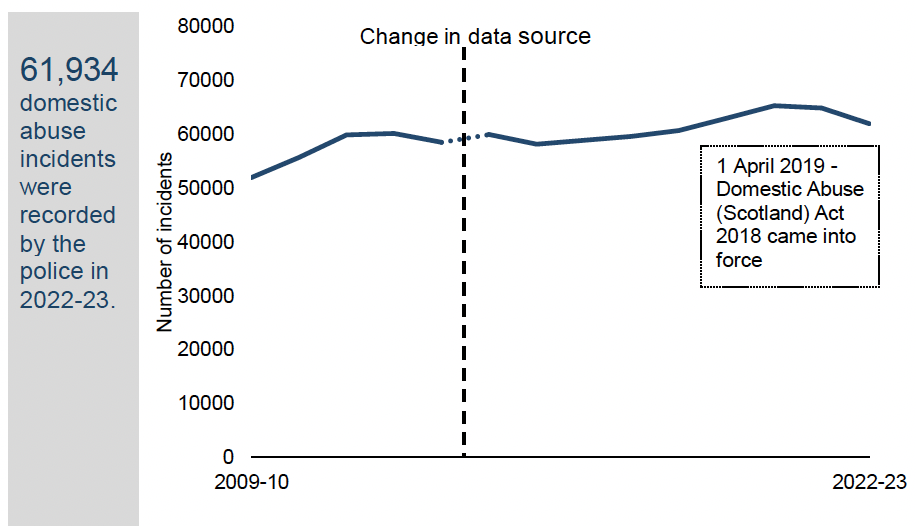
Note: See Annex 2 for information on the change in data source between 2013-14 and 2014-15.
Incidents which included a crime or offence
For those domestic abuse incidents that included the recording of at least one crime or offence in 2022-23, the most frequently recorded was Common assault, accounting for 32% of all crimes and offences. This was followed by Threatening and abusive behaviour, which accounted for 21% of all crimes and offences. (Figure 2 & Table 2).
Common assault accounted for around one-third of all crimes and offences for incidents of domestic abuse that involved a crime or offence.
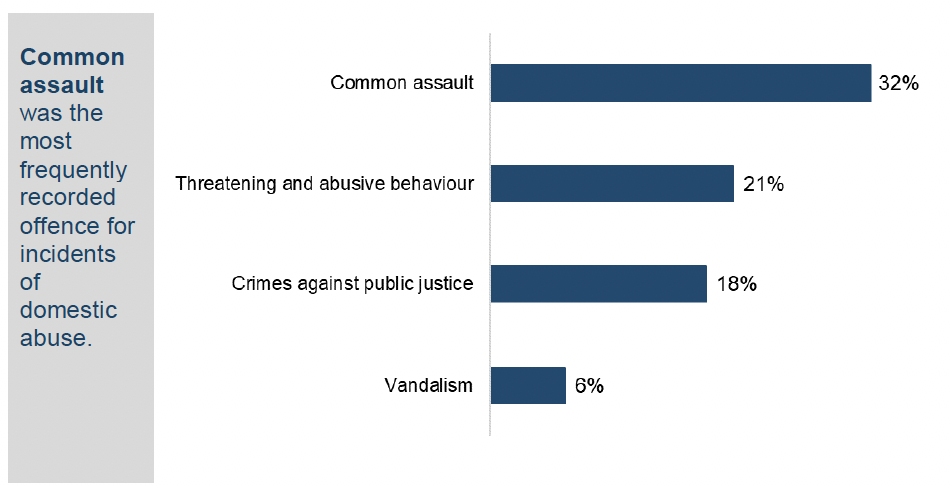
Note: An incident can have multiple crimes associated with it.
The Domestic Abuse (Scotland) Act 2018 was enacted on the 1 April 2019. Crimes recorded under the Act accounted for 5% of crimes and offences recorded as part of a domestic abuse incident in 2022-23. This is slightly higher that the proportion of crimes and offences in 2021-22 (at 4%). These amounted to 1,572 crimes recorded under the Act in 2022-23.
Section 1.2 on statistical impact provides further information on how crimes and offences might have changed due to the introduction of the Domestic Abuse (Scotland) Act 2018. Table 16 in the 'Supporting Documents' Excel workbook provides details on the characteristics of these incidents.
Incidents which did not include a crime or offence
In 2022-23, 61% of domestic abuse incidents within the interim Vulnerable Persons Database (iVPD) did not include the recording of at least one crime or offence. This reflects the definition of domestic abuse used by Police Scotland, which is not restricted to behaviour where criminal conduct has been identified and recorded.
The iVPD itself is not a crime recording system. Instead, it aims to collate disparate pieces of information about incidents into a single file, allowing officers to build a narrative about people who have reported or been involved in an incident with a domestic abuse element.
A previous review of a sample of non-criminal domestic abuse incidents found that around half of these were based on some form of argument between partners or ex-partners, which did not have any reference to a physical confrontation or threatening behaviour. Around one-in-five were based on concern about the communication or attempted communication of one partner or ex-partner towards the other (excluding any reference to an argument or a specific crime or offence). The other cases covered a diverse range of situations. Further information on this review is provided in Section 5.7.
Incidents of domestic abuse by local authority
The number of police recorded domestic abuse incidents varied at the local authority level. Between 2021-22 and 2022-23, just under a fifth (6) of local authorities recorded an increase in domestic abuse incidents, two local authorities saw very little (less than half a percentage) change and three quarters (24) recorded a decrease (Table 3).
In 2022-23, the highest percentages of incidents of domestic abuse that also included the recording of at least one crime or offence were in Moray (52%), Dumfries & Galloway (47%) and Argyll and Bute (47%). Whilst the lowest were in Shetland Islands (28%) and East Dunbartonshire (31%) (Figure 3 & Table 4).
Moray saw the highest percentage of domestic abuse incidents involving a crime or offence.
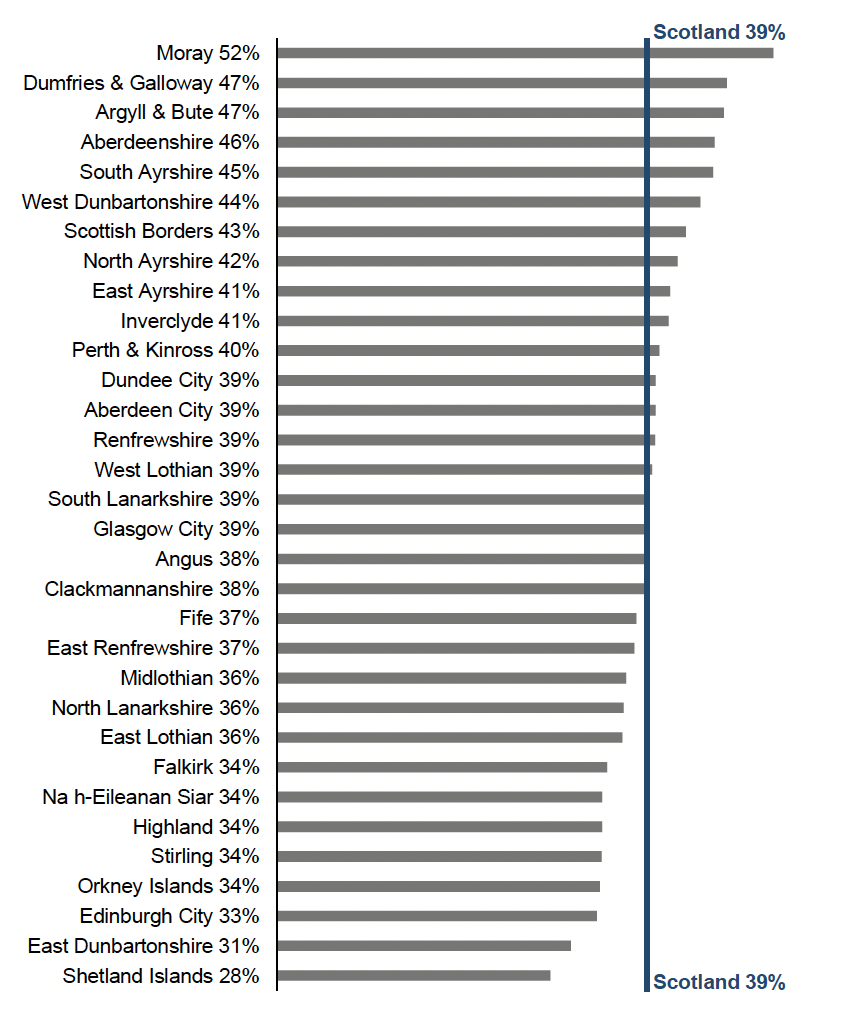
Incidents of domestic abuse per 10,000 population
Taking the population of Scotland as at mid-year 2022, there were 114 incidents of domestic abuse recorded by the police in Scotland per 10,000 population in 2022-23. At a local authority level, Dundee City (180), West Lothian (148) and Glasgow City (141) recorded the highest incident rates per 10,000 population. Orkney Islands (53), East Renfrewshire (57) and East Dunbartonshire (59) recorded the lowest rates per 10,000 population. (Figure 4 & Table 5).
Dundee has the largest number of domestic abuse incidents recorded by the police per 10,000 population with Orkney Islands having the lowest rate.
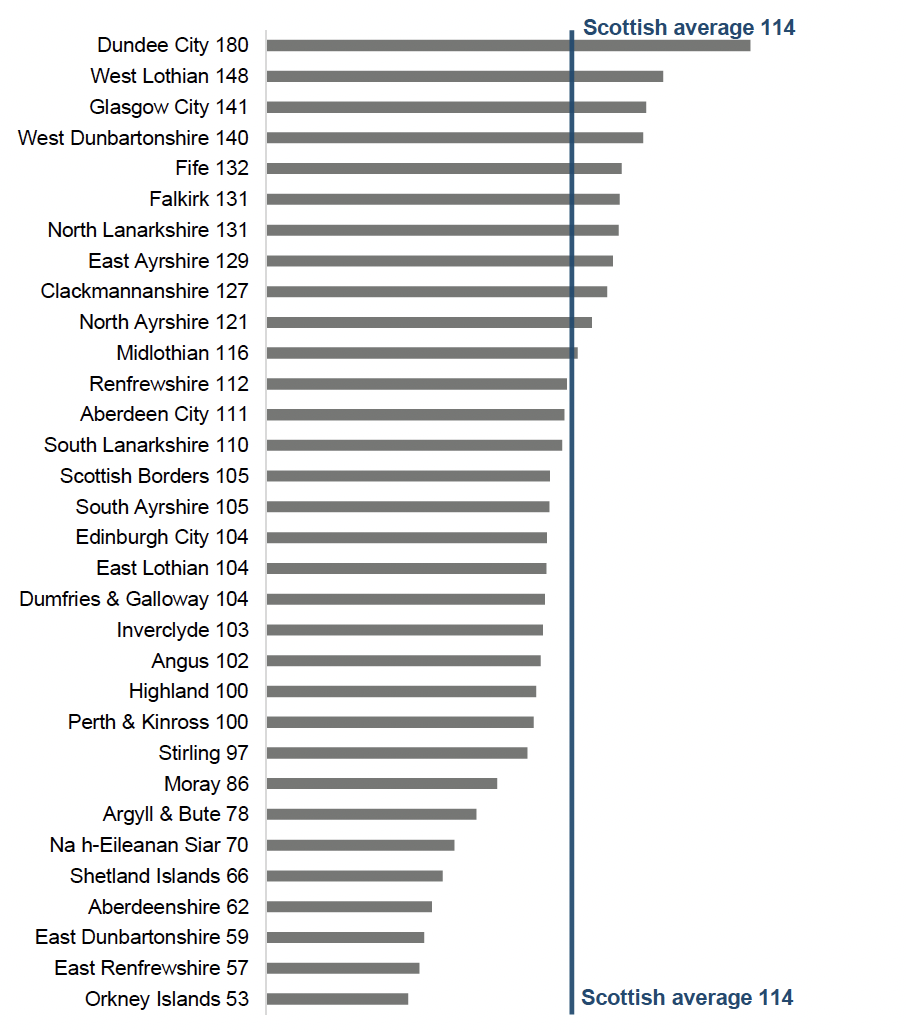
Note: Population estimates are at mid-year 2022 published by the National Records of Scotland.
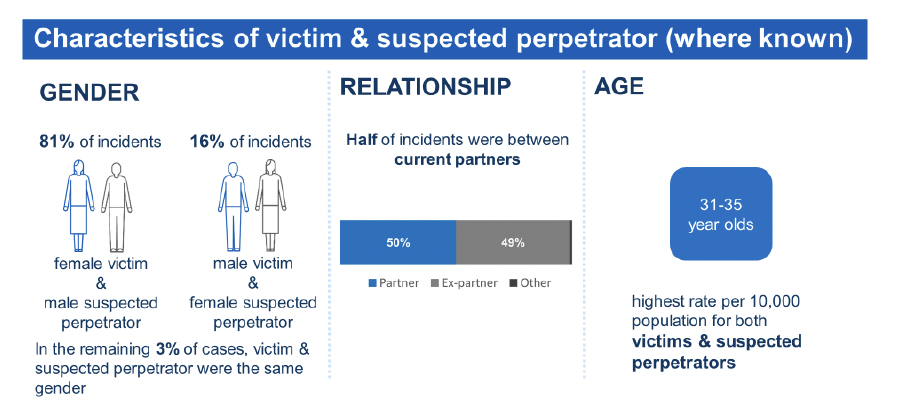
Note: Current partner is defined here as spouse/civil partner, partner and co-habitee. Ex-partner is defined as ex-spouse/civil partner and ex-partner.
Gender of victim & suspected perpetrator
Where the victim’s gender was known, the clear majority of victims in 2022-23 (83%) were female. Over four-in-five incidents (81%) of domestic abuse in 2022-23 had a female victim and a male suspected perpetrator. This remained the same as in 2021-22.
Again, where the victim’s gender was known, 17% of victims in 2022-23 were male. In 2022-23, 16% of domestic abuse incidents involved a male victim and a female suspected perpetrator. This increased slightly from 15% in 2021-22.
In the remaining 3% of domestic abuse incidents, the victim and suspected perpetrator were the same gender. This figure has remained stable over several years (Figure 5 & Table 6).
Around 4 in 5 incidents of domestic abuse, where gender was known, had a female victim and male suspected perpetrator.
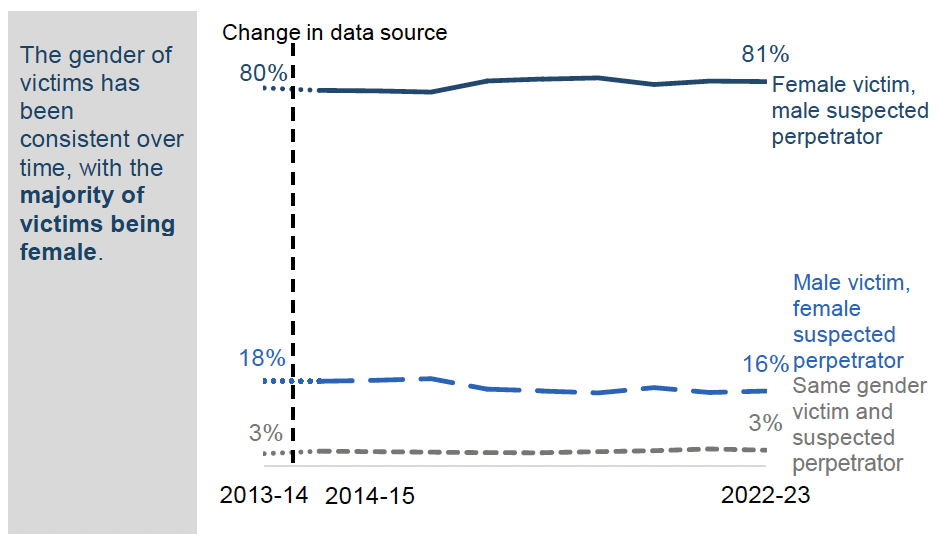
1 The figure only displays incidents where gender of victim and suspected perpetrator is known. See Annex 2 for more details on missing data.
Note: See Annex 2 for information on the change in data source between 2013-14 and 2014-15.
Relationship between victim & suspected perpetrator
In 2022-23 half (50%) of domestic abuse incidents, where the relationship[6] between the victim and suspected perpetrator was known, were between current partners. Just under half (49%) of incidents were between ex-partners. For the remaining 1% of incidents, the relationship was categorised as ‘Other’ (Table 7).
It should be noted that the proportion of incidents where the relationship between the victim and suspected perpetrator was unknown had increased in recent years (peaking at 18% in 2021-22) before dropping to 15% in 2022-23. This is due to changes in recording practice in Police Scotland, for which further information is available in Section 5.7
Age of victim & suspected perpetrator
In 2022-23, the 31 to 35 year old age group had the highest rate per 10,000 population for victims (277 incidents recorded per 10,000 population) (Table 8).
Female victims aged 31 to 35 had the highest rate (454) of incidents of domestic abuse recorded by the police per 10,000 population. 31 to 35 was also the age group with the highest rate of incidents of domestic abuse recorded per 10,000 population for male victims (92) (Figure 7 & Table 8).
In 2022-23, the 31 to 35 years old age group also had the highest incident rate per 10,000 population for suspected perpetrators (245 incidents recorded per 10,000 population) (Table 9).
The 31 to 35 year old age group had the highest rate of domestic abuse among both male suspected perpetrators (418 incidents recorded per 10,000 population) and female suspected perpetrators (79 incidents recorded per 10,000 population) (Figure 6 & Table 9).
Females aged 31-35 had the highest rate per 10,000 population for victims, whereas males aged 31-35 had the highest rate for suspected perpetrators, where gender and age were known.

1 The figure only displays incidents where gender of victim and suspected perpetrator is known. See Annex 2 for more details on missing data.
Note: Population estimates are at mid-year 2022 published by the National Records of Scotland.
Victim & suspected perpetrator repeat analysis
The iVPD enables the identification of a victim or suspected perpetrator that has previously been entered into the system for domestic abuse. A victim or suspected perpetrator can appear multiple times in the database in any one year, each classified as a separate incident.
As the iVPD was introduced and rolled out across the then 14 police divisions during 2013-14, the first and any subsequent reference to any victim or suspected perpetrator in the repeat categories below only refers to whether they were involved in an incident of domestic abuse from 2013-14 (part year depending on divisional roll out[7]) and not in any years prior to the introduction of the iVPD.
In 2022-23 there were 46,424 domestic abuse incidents with sufficient information recorded[8] to allow repeat analysis (75% of all incidents). The remaining 15,510 incidents (or 25%) did not include sufficient information to confirm one way or the other whether at least one of either the victim or suspected perpetrator had previously been recorded in an incident of domestic abuse.
For those incidents that did include sufficient information, 64% (or 29,552) had a victim and suspected perpetrator who had previously been recorded in an incident of domestic abuse – though these previously recorded incidents may have involved different partners/ex-partners. In a further 21% (9,830) of incidents, neither the victim nor the suspected perpetrator were found in the iVPD. In 15% (7,042) of incidents there was a mix of results for the victim and suspected perpetrator (i.e. only one of the victim or suspected perpetrator had previously been recorded) (Figure 7 & Table 10).
Around two-thirds of domestic abuse incidents in 2022-23 involved a victim and suspected perpetrator who had previously been recorded in a domestic abuse incident.
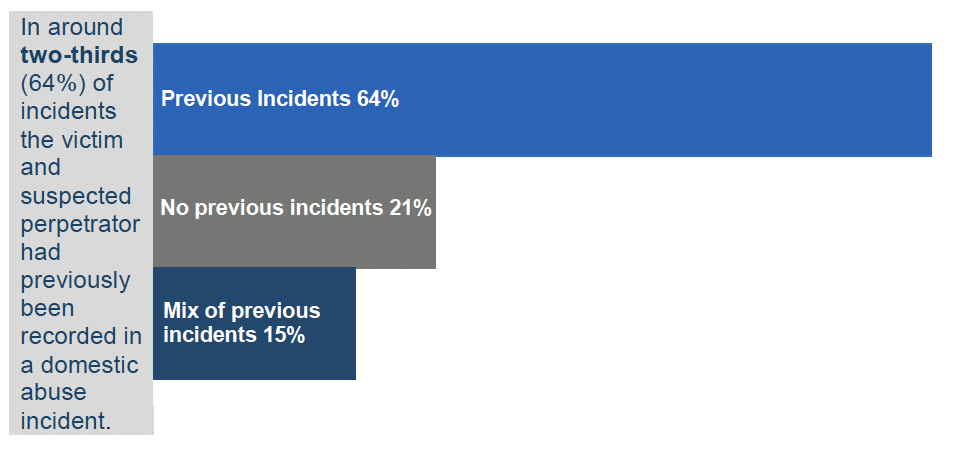
Location of incidents
In 2022-23, nine-in-ten (90%) domestic abuse incidents occurred in a home or dwelling. This is a slight increase compared to 2021-22 (89%). This figure can be split into 37% of incidents that occurred within the victim’s own home, 12% that occurred within a joint home and 5% that occurred in the suspected perpetrator’s home. Over a third (36%) of incidents occurred in an ‘other dwelling’.
The remaining 10% of incidents occurred in the street (5%), licensed premises (0.6%) or an ‘Other’ location (5%) (Figure 8 & Table 11).
More than 9 out of 10 incidents occurred in a home or dwelling, where location was known.
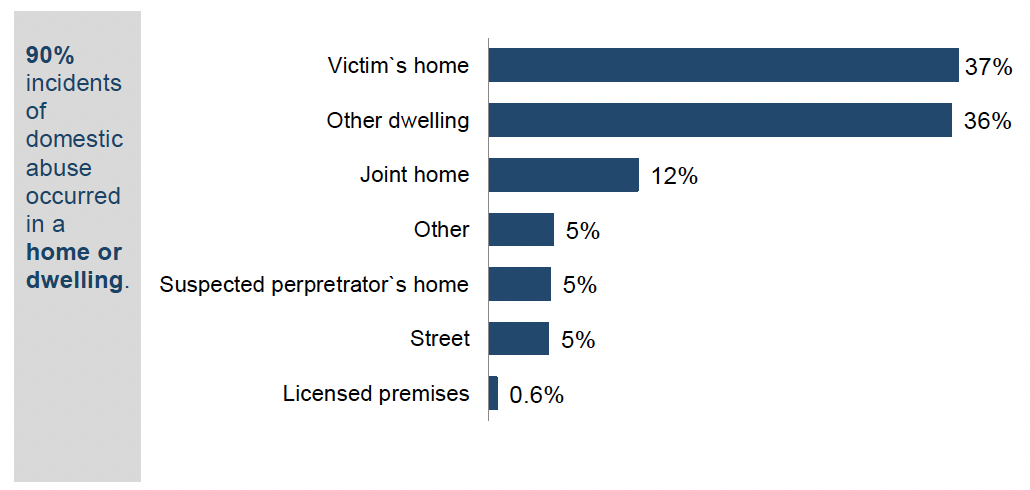
Day/month of occurrence
The following section is based on the date the incident of domestic abuse occurred, rather than when it was recorded by the police[9].
Just under a third (32%) of incidents in 2022-23 (Figure 9 & Table 14) occurred at the weekend, a slight decrease compared to the proportion in 2021-22 (33%). 29% of incidents occurred on a Monday or Friday and the remaining 39% of incidents are spread fairly evenly from Tuesday to Thursday.
When looking at the month that incidents of domestic abuse recorded by the police occurred in 2022-23 (Table 15), no clear pattern emerges from the data, with incidents fairly evenly spread out across the year.
Tables for incidents by month are available within the 'Supporting Documents' Excel workbook on the Domestic Abuse Statistics website.
Almost one third of domestic abuse incidents occurred over the weekend in 2022-23.
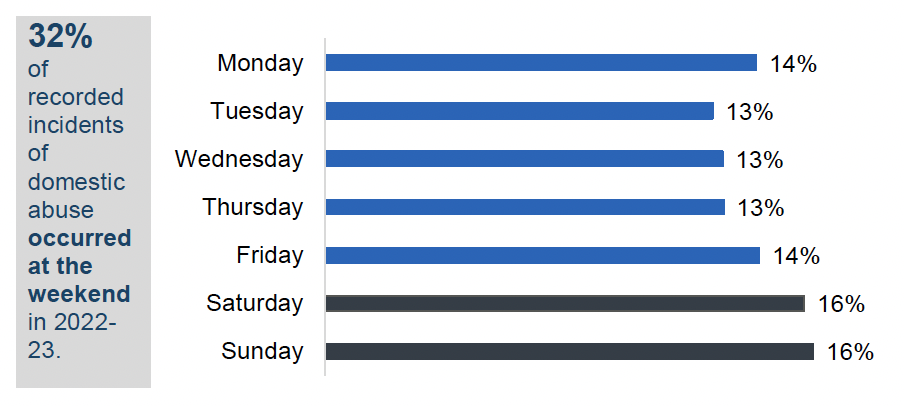
Contact
Email: Justice_Analysts@gov.scot
There is a problem
Thanks for your feedback